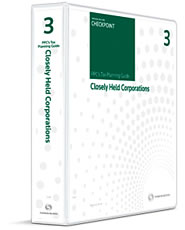We're available Monday to Friday from 8 a.m. to 6 p.m. eastern time.
Need help right now? Call 1-800-431-9025.


See also the Business Tax Planning package, which includes the online version of this PPC planning guide.
PPC's Tax Planning Guide - C Corporations addresses the issues that are encountered when responding to client questions or planning transactions. The Guide explains, in detail, the tax consequences of forming and operating the corporation to planning a tax-favored reorganization or liquidation.
The Guide also addresses relationship issues between the corporation and its owner(s). This Guide addresses shareholder basis in stock, debt, loans between the corporation and shareholders, and distributions of cash and property.
Written and reviewed by experienced practitioners to provide the practical insights and tax planning tips that only years of practice can provide. The Guide includes examples, checklists, tables, worksheets, and other tools to enable you and your staff to complete their work in a timely, consistent, and efficient manner. It also includes a Form 1120 roadmap that provides a quick and easy way to identify tax saving strategies for your clients.
C Corporations is the one resource you need to provide tax planning services efficiently and effectively to your corporate clients and their shareholders throughout the year.